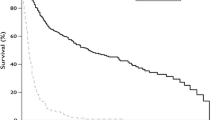Abstract
Introduction
Percutaneous endoscopic gastrostomy (PEG) tubes are an effective modality for enteral nutrition in patients with head and neck cancer; however, there have been documented case reports of “seeding” of the abdominal wall by the theoretic risk of dragging the tube along the tumor during PEG placement. The objective of this study is to determine the incidence and contributing risk factors leading to metastasis to the abdominal wall following PEG placement in patients with head and neck cancer.
Methods
A retrospective chart review was performed on patients diagnosed with head and neck malignancy who underwent PEG placement between 1/5/2009 and 12/22/2014. Variables collected included development of abdominal wall metastases, type of malignancy and tumor characteristics, smoking history, PEG placement technique, and survival following recurrence. Data were then analyzed for overall trends.
Results
Out of 777 patients analyzed, a total of five patients with head and neck malignancy were identified with abdominal wall metastasis following PEG tube placement with an overall incidence of 0.64% over an average follow-up of 27.55 months. All of these patients underwent PEG tube insertion via a Pull technique. One patient was found to have a clinically evident and symptomatic stomal metastasis, while the other four patients had radiologically detected metastases either on CT or PET scan. All of the identified patients were found to have stage IV oral cancer at time of initial diagnosis of their head and neck malignancy, followed by widespread distant metastatic disease at time of presentation with their PEG site stomal metastasis.
Conclusion
Abdominal wall metastases following PEG placement are a rare but serious complication in patients with head and neck malignancy.


Similar content being viewed by others
References
Gauderer MW, Ponsky JL, Izant RJ Jr (1980) Gastrostomy without laparotomy: a percutaneous endoscopic technique. J Pediatr Surg 15(6):872–875
Schrag SP, Sharma R, Jaik NP, Seamon MJ, Lukaszczyk JJ, Martin ND, Hoey BA, Stawicki SP (2007) Complications related to percutaneous endoscopic gastrostomy (PEG) tubes. A comprehensive clinical review. J Gastrointestin Liver Dis 16(4):407–418
Cappell MS (2007) Risk factors and risk reduction of malignant seeding of the percutaneous endoscopic gastrostomy track from pharyngoesophageal malignancy: a review of all 44 known reported cases. Am J Gastroenterol 102(6):1307–1311
Sinapi I, Navez B, Hamoir M, Schmitz S, Machiels JP, Deprez PH, Van den Eynde M (2013) Seeding of the percutaneous endoscopic gastrostomy site from head and neck carcinoma: case report and review of the literature. Head Neck 35(7):E209–E212
Brown MC (2000) Cancer metastasis at percutaneous endoscopic gastrostomy stomata is related to the hematogenous or lymphatic spread of circulating tumor cells. Am J Gastroenterol 95(11):3288–3291
Ho HS, Ngo H (1999) Gastrostomy for enteral access. A comparison among placement by laparotomy, laparoscopy, and endoscopy. Surg Endosc 13(10):991–994
Bankhead RR, Fisher CA, Rolandelli RH (2005) Gastrostomy tube placement outcomes: comparison of surgical, endoscopic, and laparoscopic methods. Nutr Clin Pract 20(6):607–612
Rustom IK, Jebreel A, Tayyab M, England RJ, Stafford ND (2006) Percutaneous endoscopic, radiological and surgical gastrostomy tubes: a comparison study in head and neck cancer patients. J Laryngol Otol 120(6):463–466
Ellrichmann M, Sergeev P, Bethge J, Arlt A, Topalidis T, Ambrosch P, Wiltfang J, Fritscher-Ravens A (2013) Prospective evaluation of malignant cell seeding after percutaneous endoscopic gastrostomy in patients with oropharyngeal/esophageal cancers. Endoscopy 45(7):526–531
Huang AT, Georgolios A, Espino S, Kaplan B, Neifeld J, Reiter ER (2013) Percutaneous endoscopic gastrostomy site metastasis from head and neck squamous cell carcinoma: case series and literature review. J Otolaryngol Head Neck Surg 42:20
Song J, Kim E, Mobley J, Vemana G, Tanagho Y, Vetter J, Bhayani S, Russo P, Fugita O, Yang SS, Iwamura M, Figenshau RS (2014) Port site metastasis after surgery for renal cell carcinoma: harbinger of future metastasis. J Urol 192(2):364–368
Curet MJ (2004) Port site metastases. Am J Surg 187(6):705–712
Chan DY, Cadeddu JA, Jarrett TW, Marshall FF, Kavoussi LR (2001) Laparoscopic radical nephrectomy: cancer control for renal cell carcinoma. J Urol 166(6):2095–2099 (discussion 2099–2100)
Acknowledgements
The authors would like to acknowledge the Foundation for Surgical Fellowships as well as head and neck surgeons, Dr. Theodore Teknos and Dr. Matthew Old, for their assistance in the completion of this study.
Author information
Authors and Affiliations
Corresponding author
Ethics declarations
Disclosures
Eleanor Fung MD, David S. Strosberg MD, Edward L. Jones MD, Rebecca Dettorre MA, CCRC, Andrew Suzo BS, CCRP, Michael P. Meara MD, Vimal K. Narula MD, and Jeffrey W. Hazey MD have no financial disclosures.
Rights and permissions
About this article
Cite this article
Fung, E., Strosberg, D.S., Jones, E.L. et al. Incidence of abdominal wall metastases following percutaneous endoscopic gastrostomy placement in patients with head and neck cancer. Surg Endosc 31, 3623–3627 (2017). https://doi.org/10.1007/s00464-016-5394-8
Received:
Accepted:
Published:
Issue Date:
DOI: https://doi.org/10.1007/s00464-016-5394-8




